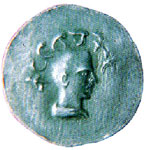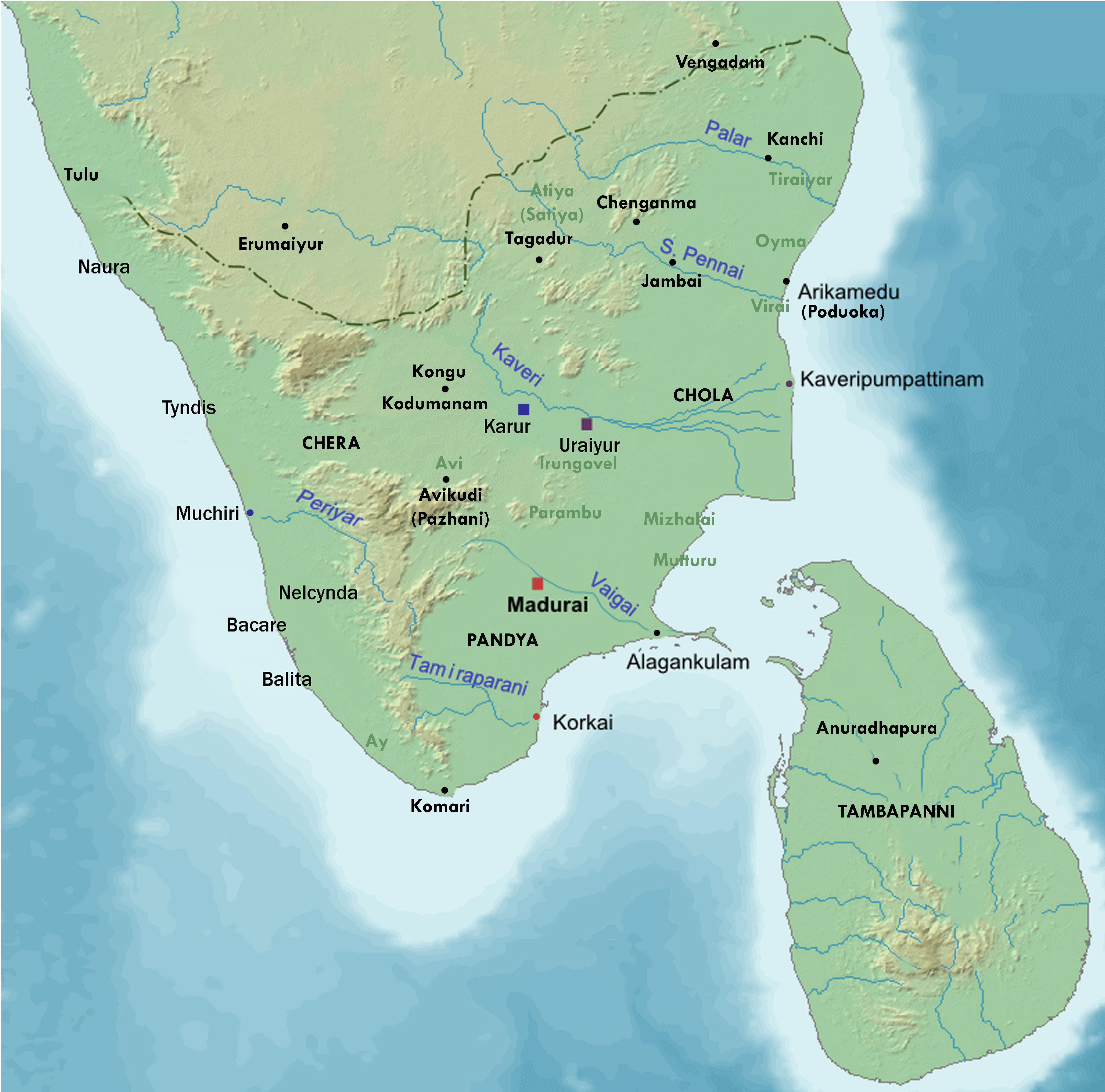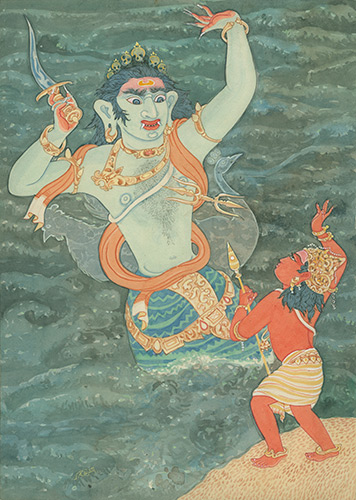|
Patiṟṟuppattu
The ''Patiṟṟuppattu'' (lit. ''Ten Tens'', sometimes spelled ''Pathitrupathu'',) is a classical Tamil poetic work and one of the Eight Anthologies (''Ettuthokai'') in Sangam literature. A panegyric collection, it contains ''puram'' (war and public life) poems. The Chera kings, known as the Cheramal, are the centre of the work. Its invocatory poem is about Mayon, or Perumal (Vishnu). The ''Patiṟṟuppattu'' originally contained ten sections of ten poems, each section dedicated to a decade of rule in ancient Kerala (Cerals, Chera); the first and last sections have been lost. Of the surviving poems, the second-to-sixth-decade-related poems are about the three generations of rulers from the Imayavaramban dynasty. The remaining poems are about the three generations of rulers from the Irumporai dynasty. In the ''Patirruppattu'' palm-leaf manuscripts, each decade ends with a (a verse epilogue followed by a prose colophon. According to U. V. Swaminatha Iyer (who rediscov ... [...More Info...] [...Related Items...] OR: [Wikipedia] [Google] [Baidu] |
Cenkuttuvan
Chenkuttuvan (c. 180 CE, literally 'the Righteous Kuttuvan'), title Kadal Pirakottiya, identified with Kadalottiya Vel Kezhu Kuttuvan, was the most celebrated Chera ruler of early historic South India. He is also mentioned in Chilappathikaram, the Tamil epic poem purportedly composed by the Chera prince Ilanko Adikal''.'' Chenkuttavan is eulogized by the poet Paranar in the fifth decade of the Pathitrupathu Collection, part of the Ettuthokai anthology of early Tamil literature. He was likely a member of the Muchiri-Karur branch (associated with present-day central Kerala) of the Chera dynasty. During his reign, the Chera territory encompassed the Malabar Coast (present-day Kerala) and the interior Kongu country (western Tamil Nadu). The influx of Yavana (Greco-Roman) gold into south India through the Indian Ocean spice trade during Chenkuttavan's reign is memorably described in ancient Tamil poems. According to Fifth Decade, Pathitrupathu, Chenkuttavan achieved a majo ... [...More Info...] [...Related Items...] OR: [Wikipedia] [Google] [Baidu] |
Chera Dynasty
The Chera dynasty ( or Cēra, ), also known as Keralaputra, from the early historic or the Sangam period in Tamil-speaking southern India, ruled over parts of present-day states Kerala and Tamil Nadu. The Cheras, known as one of the mu-ventar (the Three Crowned Kings) of Tamilakam (the Tamil Country) alongside the Cholas and Pandyas, have been documented as early as the third century BCE. The Chera country was geographically well placed at the tip of the Indian peninsula to profit from maritime trade via the extensive Indian Ocean networks. Exchange of spices, especially black pepper, with Middle Eastern or Graeco-Roman merchants is attested to in several sources. Chera influence extended over central Kerala and western Tamil Nadu until the end of the early historic period in southern India. The Cheras of the early historical period (c. second century BCE – c. third/fifth century CE) had their capital in interior Tamil country ( Vanchi-Karur, Kongu Nadu), and ports/capit ... [...More Info...] [...Related Items...] OR: [Wikipedia] [Google] [Baidu] |
Sangam Literature
The Sangam literature (Tamil language, Tamil: சங்க இலக்கியம், ''caṅka ilakkiyam''), historically known as 'the poetry of the noble ones' (Tamil language, Tamil: சான்றோர் செய்யுள், ''Cāṉṟōr ceyyuḷ''), connotes the early classical Tamil literature and is the earliest known literature of South India. The Tamil tradition links it to Legendary Tamil Sangams, legendary literary gatherings around Madurai in the ancient Pandya dynasty, Pandya kingdom. It is generally accepted by most scholars that the historical Sangam literature era, also known as the Sangam period, spanned from 100 BCE to 250 CE, on the basis of linguistic, epigraphic, archaeological, numismatic and historical data; though some scholars give a broader range of 300 BCE to 300 CE. The Eighteen Greater Texts (Patiṉeṇmēlkaṇakku), along with the Tamil grammar work Tolkāppiyam, Tolkappiyam, are collectively considered as Sangam literature. These tex ... [...More Info...] [...Related Items...] OR: [Wikipedia] [Google] [Baidu] |
Eight Anthologies
The Eight Anthologies, known as Eṭṭuttokai () or "Eight Collections" in the literature, is a classical Tamil poetic work that forms part of the Eighteen Greater Texts (''Patiṉeṇmēlkaṇakku'') anthology series of the Sangam Literature. The Eight Anthologies and its companion anthology, the Ten Idylls (''Pattuppāṭṭu''), is the oldest available Tamil literature. According to Kamil Zvelebil, a scholar of Tamil literature and history, dating these Eight Anthologies or their relative chronology is difficult, but the scholarship so far suggested that the earliest layers were composed sometime between the 1st century BCE and 2nd century CE, while the last layers were completed between 3rd and 5th century CE. Contents of the anthologies The Eight Anthologies consist of 2,371 poems varying from small stanzas of three lines in Ainkurnuru to stanzas of forty lines in Purananuru. The following poems form the Eight Anthologies: * ''Ainkurunuru'' (ஐங்குறுந� ... [...More Info...] [...Related Items...] OR: [Wikipedia] [Google] [Baidu] |
Mushika Dynasty
Mushika dynasty, also spelled Mushaka, also Eli or Ezhi, was a minor dynastic power that held sway over the region in and around Mount Ezhi (Ezhimala) in present-day Kannur, northern Kerala, south India. The country of the Ezhimala, ruled by an ancient chiefly lineage ("the Muvan"), appears in early historic (pre-Pallava) south India. Early Tamil poems contain several references to the exploits of Nannan, the ruler of Ezhimala (''fl. c.'' 180 AD) who famously defeated the Tagadur Satiyaputra ruler. Nannan was known as a great enemy of the early Chera rulers. The famous Kottayam Coin Hoard, a massive cache of mostly Julio-Claudian (Roman) coins, was also discovered from the Ezhimala country. The Ezhimala polity gradually developed into a monarchical state (known as the "Kolladesham") in the early medieval period and came under the influence of the medieval Chera kingdom. The hereditary title of the Mushika kings in the medieval period was "Ramaghata Mushaka" (Malayalam: " ... [...More Info...] [...Related Items...] OR: [Wikipedia] [Google] [Baidu] |
Sangam Era
The Sangam literature (Tamil: சங்க இலக்கியம், ''caṅka ilakkiyam''), historically known as 'the poetry of the noble ones' (Tamil: சான்றோர் செய்யுள், ''Cāṉṟōr ceyyuḷ''), connotes the early classical Tamil literature and is the earliest known literature of South India. The Tamil tradition links it to legendary literary gatherings around Madurai in the ancient Pandya kingdom. It is generally accepted by most scholars that the historical Sangam literature era, also known as the Sangam period, spanned from 100 BCE to 250 CE, on the basis of linguistic, epigraphic, archaeological, numismatic and historical data; though some scholars give a broader range of 300 BCE to 300 CE. The Eighteen Greater Texts (Patiṉeṇmēlkaṇakku), along with the Tamil grammar work Tolkappiyam, are collectively considered as Sangam literature. These texts are classified into the Ettuttokai (Eight Anthologies) and Pattupattu (Ten Idyll ... [...More Info...] [...Related Items...] OR: [Wikipedia] [Google] [Baidu] |
Silappatikaram
''Cilappatikāram'' ( IPA: ʧiləppət̪ikɑːrəm, ''lit.'' "the Tale of an Anklet"), also referred to as ''Silappathikaram'' or ''Silappatikaram'', is the earliest Tamil epic. It is a poem of 5,730 lines in almost entirely ''akaval'' (''aciriyam'') meter. The epic is a tragic love story of an ordinary couple, Kaṇṇaki and her husband Kōvalaṉ. The ''Cilappatikāram'' has more ancient roots in the Tamil bardic tradition, as Kannaki and other characters of the story are mentioned or alluded to in the Sangam literature such as in the '' Natṟiṇai'' and later texts such as the ''Kovalam Katai''. It is attributed to a prince-turned-jain-monk Iḷaṅkō Aṭikaḷ, and was probably composed in the 5th century CE (although estimates range from 2nd to 6th century CE). The ''Cilappatikāram'' is an ancient literary masterpiece. It is to the Tamil culture what the ''Iliad'' is to the Greek culture, states R. Parthasarathy. It blends the themes, mythologies and theologica ... [...More Info...] [...Related Items...] OR: [Wikipedia] [Google] [Baidu] |
Nedum Cheralathan
Nedum Cheralathan (fl. c. 155 CE, title "Imayavarampan") was a Chera ruler from early historic south India (c. 1st - 4th century CE), noted for his interactions with the Yavanas (the Greco-Roman navigators) on the Malabar Coast. He likely belonged to the Muchiri-Karur branch of the Chera dynasty. He is praised in the Second Ten of Pathitruppathu Collection, composed by poet Kannanar. In return for his work, the poet was generously rewarded with 500 settlements in a region called "Umbar Kadu" (believed to be in present-day Kerala) and a share of the revenue from the thennadu ("the southern country") for 38 years. According to these poems, Nedum Cheralathan ruled the Chera country for 58 years. Nedum Cheralathan was born to his predecessor, Uthiyan Cheralathan, and his wife Venmal Nallini, the daughter of Veliyan—who is possibly also identified as the father of the Ay chieftain Eyinan. Some accounts suggest that before Nedum Cheralathan ascended the throne, Uthiyan Cheral ... [...More Info...] [...Related Items...] OR: [Wikipedia] [Google] [Baidu] |
Eighteen Greater Texts
The Eighteen Greater Texts, known as Patiṉeṇmēlkaṇakku () in the literature, is the collection of the oldest surviving Tamil poetry. This collection is considered part of the Sangam Literature and dated approximately between 100 BCE and 200 CE. A series of eighteen major anthologies, it contains the Eight Anthologies (''Ettuthokai'') and the Ten Idylls (''Pattupattu''). The songs in the Eighteen Greater Texts anthology are set in the '' Akaval'' style. The Eighteen Greater Texts anthology contains 2,381 poems including the ten larger works belonging to the Ten Idylls collection. These poems are attributed to 473 poets. Sixteen of the 473 poets are responsible for 1,177 of the 2,279 poems for which the name of the author is known. In all, 102 of the poems are anonymous. Notably, the '' pathirruppathu'' collection exclusively collects poetry from the Cheral kings (from Kerala), whereas the other collections contain a mix of poetry patronized by diverse Tamil kings. Anth ... [...More Info...] [...Related Items...] OR: [Wikipedia] [Google] [Baidu] |
Tamil Literature
Tamil literature includes a collection of literary works that have come from a tradition spanning more than two thousand years. The oldest extant works show signs of maturity indicating an even longer period of evolution. Contributors to the Tamil literature are mainly from Tamil people from south India, including the land now comprising Tamil Nadu, Kerala, Sri Lankan Tamil people, Eelam Tamils from Sri Lanka, as well as the Tamil diaspora. The history of Tamil literature follows the history of Tamil Nadu, closely following the social, economical, political and cultural trends of various periods. The early Sangam literature, dated before 300 BCE, contain anthologies of various poets dealing with many aspects of life, including love, war, social values and religion.Akananuru (1, 15, 31, 55, 61, 65, 91, 97, 101, 115, 127, 187, 197, 201, 211, 233, 251, 265, 281, 311, 325, 331, 347, 349, 359, 393, 281, 295), Kurunthogai (11), and Natrinai (14, 75) are dated before 300 BCE. This was ... [...More Info...] [...Related Items...] OR: [Wikipedia] [Google] [Baidu] |
Murugan
Kartikeya (/ kɑɾt̪ɪkejə/; ), also known as Skanda ( /skən̪d̪ə/), Subrahmanya (/ sʊbɾəɦməɲjə/, /ɕʊ-/), Shanmukha ( /ɕɑnmʊkʰə/) and Murugan (/ mʊɾʊgən/), is the Hindu god of war. He is generally described as the son of the deities Shiva and Parvati and the brother of Ganesha. Kartikeya has been an important deity in the Indian subcontinent since ancient times. Mentions of Skanda in the Sanskrit literature data back to fifth century BCE and the mythology relating to Kartikeya became widespread in North India around the second century BCE. Archaeological evidence from the first century CE and earlier shows an association of his iconography with Agni, the Hindu god of fire, indicating that Kartikeya was a significant deity in early Hinduism. He is hailed as the "favoured god of the Tamils", and the tutelary deity of the Kurinji region in Sangam literature, whose cult gained popularity later. As per theologists, the Tamil deity of Murugan coalesced ... [...More Info...] [...Related Items...] OR: [Wikipedia] [Google] [Baidu] |
Paranar
Paranar (Tamil: பரணர்) (c. 1st century CE) was a poet of the Sangam period, to whom 84 verses of the Sangam literature have been attributed, besides verse 6 of the Tiruvalluva Maalai. Biography Paranar belonged to the Paanar caste. He was the friend of Kapilar and Nakkirar I. He has sung various kings, namely, Kadal Pirakkottiya Senguttuvan, Cholan Uruvapatrer Ilanchet Senni, Cheraman Kadalottiya Velkelu Kuttuvan, Kudakko Neduncheralaadhan, and Cholan Verpatradakkai Perunarkilli. Contribution to the Sangam literature Paranar has written about 85 verses, including 17 in Kurunthogai, 12 in Natrinai, 32 in Agananuru, 13 in Purananuru, 10 in Pathitrupathu, and 1 in Tiruvalluva Maalai. By praising the Chera king Senguttuvan, Paranar received Udambarkaattu Vaari and his son prince Kuttuvan Cheral as 'present'. Views on Valluvar and the Kural Paranar opines about Valluvar and the Kural text thus: See also * Sangam literature * List of Sangam poets * Tiruvalluva Maal ... [...More Info...] [...Related Items...] OR: [Wikipedia] [Google] [Baidu] |





